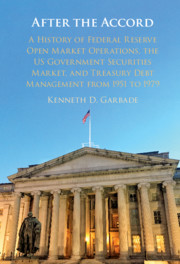Refine search
Actions for selected content:
7 results
11 - Policy Instruments for Reserves Management
- from Part III - The New Regime
-
- Book:
- After the Accord
- Published online:
- 14 January 2021
- Print publication:
- 04 February 2021, pp 150-166
-
- Chapter
- Export citation
22 - Repurchase Agreements in the 1960s
- from Part VI - The 1960s
-
- Book:
- After the Accord
- Published online:
- 14 January 2021
- Print publication:
- 04 February 2021, pp 351-368
-
- Chapter
- Export citation
21 - Monetary Policy in the 1960s
- from Part VI - The 1960s
-
- Book:
- After the Accord
- Published online:
- 14 January 2021
- Print publication:
- 04 February 2021, pp 337-350
-
- Chapter
- Export citation
13 - Pragmatism in the Accommodation of Treasury Offerings
- from Part III - The New Regime
-
- Book:
- After the Accord
- Published online:
- 14 January 2021
- Print publication:
- 04 February 2021, pp 187-194
-
- Chapter
- Export citation
14 - 1956 and 1957
- from Part III - The New Regime
-
- Book:
- After the Accord
- Published online:
- 14 January 2021
- Print publication:
- 04 February 2021, pp 195-212
-
- Chapter
- Export citation
1 - Introduction
-
- Book:
- After the Accord
- Published online:
- 14 January 2021
- Print publication:
- 04 February 2021, pp 1-6
-
- Chapter
- Export citation

After the Accord
- A History of Federal Reserve Open Market Operations, the US Government Securities Market, and Treasury Debt Management from 1951 to 1979
-
- Published online:
- 14 January 2021
- Print publication:
- 04 February 2021
